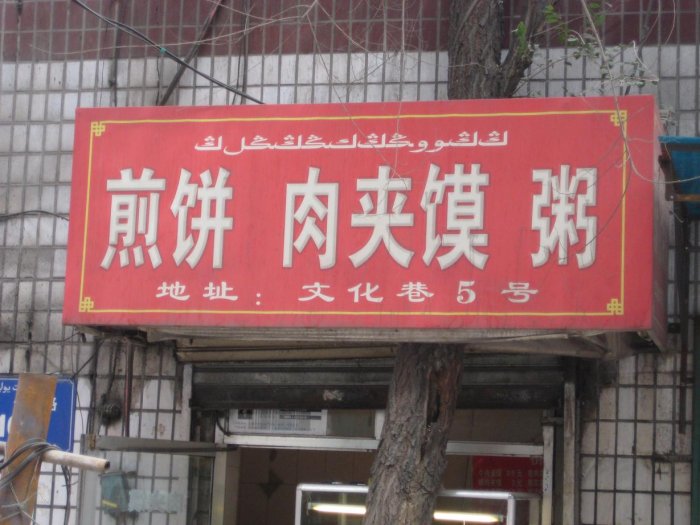Gibberish Uyghur
« previous post | next post »
On a very interesting and informative blog called "This is Xinjiang", we find the following sign over the entrance to an Ürümchi restaurant:
The blogger, an anonymous "foreign university teacher in China's western frontier", captions the photograph thus:
The diverse number of scripts found on Xinjiang signs — Arabic, Chinese, Mongolian, and Russian — often present a bewildering challenge to Westerners who are used to the Latin alphabet. Here, no one writes English in public places. But Xinjiang's multilingualism can even mislead the locals. For example, this restaurant, located in downtown Urumqi, advertises "Pancakes, Hamburgers, Porridge" in Chinese characters. Unfortunately, the Uyghur "translation" written above that is: ngngoongngkngngnglng.
Who's pulling whose leg? It is evident that, in this case, the "Uyghur" language written in Arabic script is there for purely decorative purposes, reminiscent of the mirror-reversed Chinese characters in a New Yorker ad sponsored by the Massachusetts Office of Travel and Tourism that I wrote about here, or the Hong Kong strip-club flyer used to decorate the cover of a China-themed issue of MaxPlanckForschung.
My guess is that even someone who doesn't know Arabic script or Uyghur language would be suspicious of the numerous repetitions of just a few letters.
Such signage is supposed to be supervised by the official Working Comittee for the Languages and Scripts of Minority Nationalities (少数民 族语言文字工作委员会 Az sanliq milletler til-yeziq xizmet komiteti).
And this is another way to "read" the Uyghur letters: ng_ng_o_o_ng_ ng_k_ng_ng_ ng_lng. Try it without choking!

Therese said,
September 29, 2009 @ 12:43 am
Man, I want a jianbing now.
Nathan Myers said,
September 29, 2009 @ 12:45 am
Evidently Cthulhu got to the translator. It's too late now.
rpsms said,
September 29, 2009 @ 10:59 am
Coul it be a form of "lorem ipsum" that got through the design process?
jubin said,
September 29, 2009 @ 12:48 pm
My favorite case of this was an old South Park episode where they visited Iran and all the text said "Kurosh, Dariush" (Cyrus, Darius) in Farsi. Just a little outdated.
Leonardo Boiko said,
September 29, 2009 @ 1:35 pm
@rpsms: if so, it’s a pretty lousy lorem ipsum…
Jesse said,
September 30, 2009 @ 12:40 am
The anonymous blogger reveals her highly improbable name here.
Re: the non-gibberish part of the sign. The zh.wikipedia article for 肉夹馍 offers an unexpected lesson in Mandarin compound formation. The name of this snack is "meat enclosing bun", and — just like in English — there are two ways to analyze this sequence. Common sense and these photos tell us that it's not "meat enclosing a bun", but a "meat enclosing-bun". And definitely not a hamburger.
Lane said,
September 30, 2009 @ 7:05 am
The letters also don't connect up and change shape properly as if they were Arabic letters, which usually have different forms in the beginning, middle and end of words. The first "ng" (on the right side) is actually the word-final and stand-alone shape. Most word processors will correct this automatically, so it seems these were just chosen from a basket of letter shapes and put there.
Panu said,
September 30, 2009 @ 10:35 am
The anonymous blogger reveals her highly improbable name here.
"Sakura Christmas"!!!!???
rpsms said,
September 30, 2009 @ 10:45 am
If they are a form of end-of-word ligature glyph, I am now curious to see if they map to something that makes more sense in another typeface such as Wingdings. Especially if what we see in the sign is the Arial equivalent for Uyghur.
A non-trivial percentage of people don't know to include font subsets in their pdfs (etc.) when sending them out for printing, and if the recipient doesn't have the right typeface, their software will force a default one. Wingdings, single-glyph fractions, and decorative typefaces are typically pictorial glyphs mapped to the alpha-numeric glyph subrange.
Chris Brew said,
October 1, 2009 @ 9:22 am
ngngoongngkngngnglng
is very reminiscent of Spike Milligan's famous poem
http://www.poemhunter.com/poem/on-the-ning-nang-nong/
could he perhaps be writing uighur from beyond the grave?
His epitaph was "Dúirt mé leat go raibh mé breoite", because the diocese of Chichester objected to "I told you I was ill". It's the same thing, but in Irish.
Lareina said,
October 1, 2009 @ 8:44 pm
I think these fake restaurant are just fooling ppl to believe, you know, like "we are authentic xinjiang food, we even have Xinjiang characters on our gate" but this absly make NO sense….
Dmajor said,
October 5, 2009 @ 10:37 pm
> ngngoongngkngngnglng
Sounds like Curly Howard.
Arienne Dwyer said,
March 1, 2010 @ 5:26 pm
Uyghurs refer to this sort of token-Uyghur signage as "eyebrows" over the main Chinese-language sign.